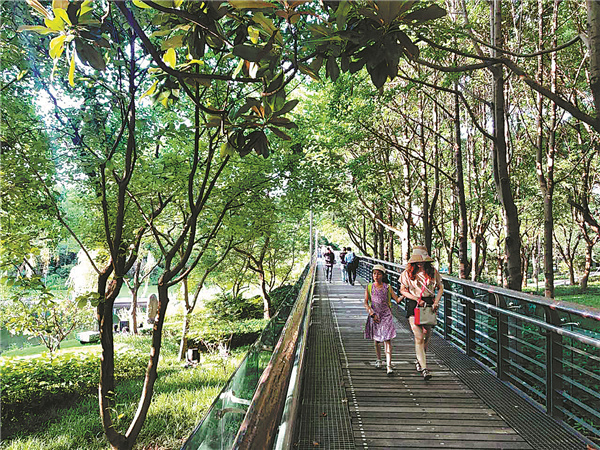

"Compared with London, New York and Singapore, the current scale and quality of green spaces in Shanghai still has room to improve," says Deng Jianping, director of the bureau.
"We plan to make greenery a soft power of the city's core competitiveness."
According to the city's 14th Five-Year Plan (2021-25), green spaces will be constructed along the city's outer Ring Road and eight "green wedges" will be built. Four of them, namely Senlan, Biyun, Sanlin and Zhangjiabang, will be completed by 2025, while the construction of the rest will be pushed forward as well.
The city's green trail will be extended along rivers to create public spaces and ecological corridors. A total of 1,000 kilometers of green trail will be added in the next five years. In the suburbs, the trail will run along forest strips. In downtown areas, it will run along the riverbanks.
Besides enhancing a project that turned 87 km of embankment along the Huangpu River and Suzhou Creek into leisure spaces over the past five years, the plan also includes green waterfront construction along rivers such as the Chuanyang and Dianpu and Zhangjiabang.
Deng says, "Shanghai aims to become a park city, a forest city and a wetland city, and foundations for those long-range objectives will be laid soundly by 2025."
Parks' team at AECOM has also participated in the landscape planning of Zhangjiabang Green Wedge, which consists of large green spaces along the 23.5-km Zhangjiabang River that connects the Huangpu River and the East China Sea.
According to the final plan released by the Pudong district government, the construction of the wedge-shaped green space was split into multiple phases, and the total area of green spaces and water bodies will cover more than 600 hectares, twice the size the Central Park in New York.
"Our vision is to create large continuously connected areas for people to enjoy along the riverside without having to crossover major roads," says Parks.
"I hope that people can one day run and cycle along the Zhangjiabang, from the Huangpu all the way to the East China Sea and back," he says.
"That will be a great 50-km route."